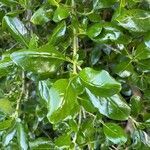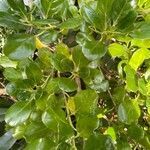A shrub. It has several stems. It grows up to 2.5 m high. The branches are stiff and spreading. They often form dense thickets. The leaves are almost rounded and leathery. They are shiny and deep green above and pale green underneath. The flowers are yellowish green. They occur in dense clusters. The fruit are orange-red. They are 6-8 mm long.



